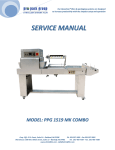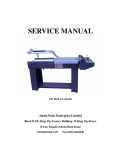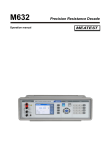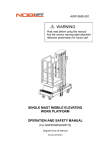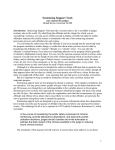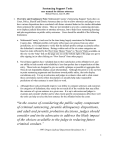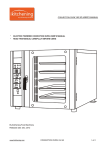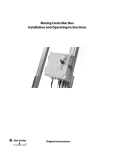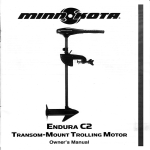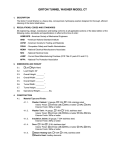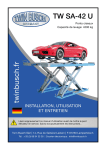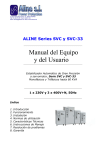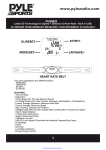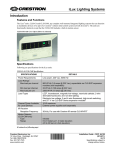Download SERVICE MANUAL
Transcript
SERVICE MANUAL MODEL: AP-1519A-COMBO Page2/29 AP-1519A Service Manual IMPORTANT-PLEASE READ THIS CAREFULLY The development of a good safety program, that is rigidly enforced, is absolutely imperative when involved in the operation of industrial equipment. Our machinery is well designed and includes extremely important safety features. The part you play through proper installation and maintenance procedures is of far greater significance than our designs. Only properly trained individuals following rigidly enforced safety rules, should be allowed to operate these machines. 2 Page3/29 AP-1519A Service Manual TABLE OF CONTENTS Preface Unpacking Warranty Warnings Sealer Section Description and Specifications Film Threading Sequence of Operation Troubleshooting Chart Service Adjustments Maintenance Period Electrical Diagram Shrinking Tunnel Section Description and Specifications Operating Panel Diagram Sequence of Operation Temperature Control Adjustment Inverter Adjustment Troubleshooting Troubleshooting-Conveyor Malfunction Troubleshooting-No Air Flow Troubleshooting-No Heat Maintenance Maintenance-Replace Conveyor Rollers Maintenance-Replace Conveyor Motor Maintenance-Replace Temperature Controller Maintenance-Replace Inverter 3 Page4/29 AP-1519A Service Manual Maintenance-Replace Blower Motor Maintenance Period Electrical Diagram ELECTRICAL PARTS LIST(1519) 4 Page5/29 AP-1519A Service Manual Preface UNPACKING If goods are received short or in a damaged condition, it is important that you notify the carrier’s driver before he leaves your company and insist on a notation of the loss or damage across the face of the freight bill. Unless this is done, no claim can be enforced against the trans portion. If concealed loss or damage is discovered, notify the carrier at once and insist on an inspection. This absolutely necessary! A concealed damage report must be made no later ten (10) days from the date the shipment was delivered. Unless you do this, the carrier will not consider any claim for loss or damage. The carrier’s agent will then make an inspection and grant a concealed damage notation. If you give the transportation company a clear receipt for the goods the have been damaged or lost in transit, you do so at your own risk and expense. All claims must be filed within six (6) months of delivery date or carrier will not accept them. We are willing to assist in every possible manner to collect claims for loss or damage; however, this does not make Alpha-Pack responsible for collection on claims or replacement of material. 5 Page6/29 AP-1519A Service Manual WARRANTY OPERATING AND MAINTENANCE MANUAL The operating and maintenance manual has been carefully prepared to provide the user with all the information needed to properly install, operate, and maintain your Alpha-PACK equipment. Please read this manual carefully and refer to it for information on the care and use of your Alpha-Pack equipment. It is recommended that additional copies be ordered for use by production, maintenance, and supervisory personnel. Although care design of this sealer incorporates safeguards to protect personnel, care should be used in operating, adjusting, and servicing. Attention is directed to the warranty which accompanies all your equipment. The terms and conditions of this warranty apply only to unmodified units. Any unauthorized modifications to the equipment voids automatically this warranty. We warrant each new product manufactured to be free from defects in material and workmanship for a period of one (1) year from date of shipment by us. This warranty is not transferable with any subsequent resale. Defective parts under warranty must be returned to us freight prepaid. our sole obligation and purchaser’s sole remedy in the event of a warranty dispute shall be, at our option, to repair or replace the part in question Labor incurred in removing or installing the defective part is not covered by this warranty. Prior to returning any parts for any reason, contact us for a Return Authorization Number. This number must accompany all returns. This warranty shall not apply if equipment has been tampered with, misused, improperly installed, altered, or has received damage due to abuse, carelessness, accident or failure to follow recommended regular maintenance procedures or has been serviced by someone other than a duly authorized factory representative without the express written consent of us. This warranty is in lien of all other warranties, expressed or implied, including but not limited to warranties of merchantability and fitness for a particular purpose, non-infringement or any other matter. We shall have no liability to any person for direct, indirect, incidental or consequential damages or delay resulting from any defect negligence, or tort and customer hereby waives for itself any and all claims for punitive damages and all claims of negligence of strict liability or both. In no event shall our liability exceed the purchase price of the product which was actually paid. We reserves the right to make changes, additions, or improvements to our products with no obligation to make such changes in any previously shipped product covered by this warranty. We shall not be held liable for any damages arising out of or in connection with the operation of the equipment should customer or its agent fail to maintain equipment in safe operating condition. This warranty shall become unenforceable if and to the extent the customer or its agents remove, disconnect, or otherwise render useless any safety device and or parts designed or affixed by us or fails to maintain and service equipment in a manner as advised. 6 Page7/29 AP-1519A Service Manual WARNINGS Every effort has been taken to ensure your safety while operating this machine; however, there still remain certain risks. Do not allow this machine to be operated before informing all personnel of the following warnings. WARNING………. Do not tamper with the electrical wiring. Only use a licensed electrician for maintenance. Always disconnect the electrical power before attempting any maintenance to all electrical and/or moving parts. WARNING………. In order to prevent injury to personnel and/or machinery DO NOT INCREASE SETTINGS OR RATINGS ON EITHER ELECTRICAL OR MECHANICAL OVERLOAD SAFETY DEVICES. WARNING………. KEEP HANDS AWAY FROM MOVTNG CONVEYORS AND ASSEMBLIES. Conveyor belts that have become worn or frayed are capable of being hazardous. They should be replaced promptly. WARNING………. NEVER OPERATE THIS OR ANY MOVING EQUIPMENT WTTHOUT ALL COVERS AND GUARDS IN PLACE. The internal mechanism of most packaging machinery contains numerous shear, pinch, and in running nip points, many of which are capable of causing severe injury and/or permanent disfigurement. WARNING………. To minimize the potential for personnel injury, always be sure that machine operators and others working on the machinery are properly trained in the correct usage of the correct usage of the equipment and properly instructed regarding the safety procedures for operation. WARNING………. Heat sealing arms and jaws on packaging machinery can become very hot after a period of use. KEEP HANDS AWAY WHILE IN OPERATION AND USE CAUTION IF THE MACHINE HAS BEEN RUNNING RECENTLY. WARNING………. ANY MODIFICATIONS TO EITHER THE ELECTRICAL CIRCUITRY OR THE MECHANICAL ASSEMBLIES OF THE MACHINERY WILL VOID ANY WARRANTTES ASSOCIATED WITH THIS EQUIPMENT. Such modifications may introduce hazards that would not otherwise be associated with this machinery. We will not be responsible for any consequences resulting from such unauthorized modifications. WARNING………. 7 Page8/29 AP-1519A Service Manual The use of certain types of plastic films in sealing and/or shrinking equipment may result in the release of HAZARDOUS FUMES due to the degradation of the film at high temperatures. Before using any plastic film in this equipment, the manufacturer or supplier of the film should be contacted for specific information concerning the potential release of hazardous fumes. ADEQUATE VENTILATION MUST BE PROVIDED AT ALL TIMES. Do not attempt to install, adjust, or operate this machine without first reading the contents of this manual. Although the design of the equipment incorporates safeguards to protect operating and maintenance personnel, care should be used in operating, adjusting, and servicing. 8 Page9/29 AP-1519A Service Manual SEALER SECTION DESCRIPTION AND SPECIFICATIONS OF SEALER DESCRIPTION: The purpose of sealer is for low volume packaging requiring excellent seals and minimal maintenance. It features impulse and polyethylene modes for sealing bags. This model incorporates an pneumatic hold-down system, allowing the operator to load another package while the preceding package is being sealed. This system provides consistent seals. In addition, a package take-away convey or increases production speed by automatically discharging product into the tunnel. SPECIFICATIONS: Seal Area: Width-16” Length-22” FILM THREADING DLAGRAM Goods Pin Perforator A-Wind FILM B-Wind Rollers 9 Page10/29 AP-1519A Service Manual SEQUENCE OF OPERATION OPERATING PANEL START BUTTON CONVEYOR SEALING 1. START BUTTON-in manual mode, starting the sealer 2. CONVEYOR-the conveyor running delay time after finishing sealing 3. SEALING-the sealing time The sequence of operating A. B. C. Connecting the single phase power-220VAC, 50HZ with earth wire; Product is placed on the film separator tray. The product tray functions as a means to separate the film, allowing placement of product between upper and lower portions of the film. D. Move product into seal head area by pushing the product to the left. E. Press the power button, by pushing the cover handle with a pressure of 10-15kg, the cover rests on the sealing blade. As the seal head meets the lower seal pad, the machine automatically activates the seal wires. The sealing timer is adjustable from zero (0) to three (3) seconds. F. Take-away Conveyor Unit-Once the seal is completed, the seal head automatically releases and the take-away conveyor begins to run. It is adjustable from zero (0) to three (6) seconds. G. . The operator may then load the next package onto the product tray, thus speeding up the sealing operation. NOTE: If too much tension is on the film while the bag is being made, the seals will, more than likely, be weak or will "blowout" in the seal area while passing through the shrink tunnel. Make sure to relax the film tension prior to sealing. MOUNTING FILM Select the proper width of center-fold film for the item being packaged, allowing for width and height of package. With the package properly positioned within the film in the sealing area, allow sufficient film to overlap the sealing bars so that a seal may readily be made without any possibility of open areas due to insufficient film. Place film roll on cradle mount film rack. See page 10 for a detailed drawing. The center-fold is to Page11/29 AP-1519A Service Manual be placed away from the operator, toward the rear of the machine. Position film roll on rack and tighten film guide nuts to hold film roll in position. Decide whether the film is A-wind or B-wind and thread it accordingly through the pin perforator. Note that the perforator wheel turns freely and is not binding. See diagram on page . Once threaded, separate film top from bottom and insert product tray between. Make sure that the center-fold of film is placed at the rear of the product tray. This allows the operator to insert product between the layers of film on the product tray and to prepare to move product and film into the sealing area. When threading film, make sure to pull more than sufficient film through the rollers, across the product tray, and into the sealing area to ensure sufficient film to begin operation. Place product against rear of film separator tray. Then move product into seal area. Be sure to leave the bag loose around the product when making the seal. This helps eliminate the seals from blowing out in the shrink tunnel. This completes threading and/or mounting film. PIN PERFORATOR Located between the lower idler rollers, the pin perforator is completely synchronized with the seal arm and creates holes for air escape during shrinking each time a new seal is made. The pin perforator is adjustable and must be properly placed in conjunction with the width of the desired package. The positioning should always be re-evaluated when setting the machine for different size product or different size film. Adjustments may be made with the adjustment knob attached to the bottom of the film rack. FILM BRAKE The film brake is located on the operator side of the film cradle. It serves to create tension on the dispensing film, in order to prevent over-run and/or slack. From time to time, the operator shoulder-evaluate its setting to ensure proper tension. PRODUCT TRAY The product tray is an adjustable metal platform used to separate film and to insert product between top and bottom layers of film. The tray is adjustable to achieve proper depth, equal to the depth of the package; thereby, allowing product to be placed exactly in the center fold of the film each time. 11 Page12/29 AP-1519A Service Manual TROUBLE SHOOTING CHART The following trouble shooting chart is provided to aid in determining the source of any operation difficulties which may develop. In performing the tests and checks which follow, carefully inspect for any loose components, broken or loose wires, poor electrical connections, etc. While testing the various switches, controls, relays, transformers, etc. For checking electrical problems, use a voltage meter. Note: While trouble shooting use caution to avoid danger of electrical shock. When power is not required for checking for the presence or value of voltages used. Always have it disconnected. Refer to components placement sheet and electrical schematic diagrams to assist in all trouble shooting efforts. Problem Procedure THE SEAL HEAD DON’T 1. The sealing timer must set above 0 DOWN 2. The magnet valve is not good 3. Check the cover handle is available. SHORT ELEMENT LINE 1. Improper element installation. 2. Weak spring at element termination (left end of front element, rear end of side element). If questionable, replace. 3. Be certain that heat sink has firm flat contact with element. If deformed, replace or straighten heat sink. WEAK SEALS AND/OR 1. Improper operating technique. Too much film tension, make sure film POOR FILM CUT-OFF is relaxed prior to sealing. 2. Check sealing element wire to see if cleaning or replacement is necessary. 3. Burned Teflon tapes 1/2” or 3/4” replace. 4.Wavy silicone rubber sealing pad Replace. 5. Seal pad pressure incorrect. 6. Hold-down pressure uneven or incorrect on magnets. CONVEYOR DO NOT 1. Check Breaker BS2. 12 Page13/29 AP-1519A Service Manual RUN 2. Check conveyor timer KT1, make sure timer is not set on zero. 3. Check conveyor belt and make sure it is not too tight. 4. Check that conveyor motor sprocket set screws are not loose on shaft. 5. Check that conveyor chain is not jammed or broken. 6. Make sure wire number R, S & T are connected to the conveyor motor. 7. Make sure wire number S & T are connected to capacitor C. 8. Make sure the Pulse Switch can work properly. EXCESSIVE FILM DRAG 1. Check for proper film threading. (See diagram on page 13). 2. Loosen film roll brake. (See diagram.) EXCESSIVE FILM 1. Tighten film roll brake. WINDING OR “SPILL” 13 Page14/29 AP-1519A Service Manual SERVICE ADJUSTMENTS SEALING ELEMENT REPLACEMENT The sealing elements are subject to constant wear and will eventually require replacement. To replace sealing elements proceed as described below. REPLACING FRONT ELEMENT 1. Loosen the two set screws on the side and front bars. (This holds the opposite end of the front seal wire in place.) Loosen the two set screws on the compensator. Remove old wire. When the wire was originally installed it extended out of the top of the bar 2” and had a loop or book on it to prevent injury to hands. It may be necessary to cut the loop off to remove seal wire. 2. Cut off a piece of new seal wire 5” or 6” longer than necessary. Using long-nosed pliers, measure 3” from one end and form a 90 degree bend. Push the wire through the corner bead and tighten set screws. Note: For safety, lease take your pliers and bend a loop in the wire that is extending out of the top of the bar. 3. Remount heat sink making sure it fits snug against the wire. If it is not snug, the wire will become too hot in this area and break. 4. Make sure the wire lies properly in the bead groove the entire length of the bar. If not, pulse the machine, With the head in the up position. Do this several times to stretch the wire then reset wire temperature for making bags. IMPORTANT: After replacing sealing wire, be sure to adjust the setting of the element compensator. TAPE REPLACEMENT The item most subject to wear on the sealer is the Teflon tape used to cover the silicone sponge rubber on the sealing bar. This tape should never be permitted to burn through. To replace tape, proceed as follows: 1. Strip off old tape. 2. Cut off proper length of new Teflon, peel off backing, and press new tape into position. SILICONE RUBBER SEALING PAD REPLACEMENT Occasionally it will be necessary to replace the silicone rubber sealing pads. This should be done if the following effect are noted: Gaps in the seal Weak seals Improper film cut-off Excessive sealing pressure required To replace rubber, proceed as follows: 1. Seal pads are designed with a channel for easy replacement. Pull silicone rubber out of the channel. 14 Page15/29 AP-1519A Service Manual 2. Replace with new silicone rubber. Press rubber back into channel. 3. Put 3/4” – 10 mil Teflon tape on top of rubber. 4. Put 1/2”- 10 mil Teflon tape over the 3/4” tape. ELEMENT PULSE SWITCH ADJUSYMENT The sealing cycle should not begin until the sealing head is within 1/4”or less of the film to be sealed. If the magnets energize before the head is within 1/4” of the film, loosen the lock-nut and turn the screw (located at the rear end of the side seal bar )up slightly (counterclockwise when viewed from above). The correct adjustment has been obtained when the magnets energize just as the seal bar comes into contact with lower pads. CONVEYOR From time to time it will be necessary to disassemble the convey as it will need adjustments or replacement of worn parts and general maintenance. The following information is given to assist the operator in that general fashion. If the problem does not recidivate itself with these general exlanation, discuss it with an authorized distributor of Alpha-Pack or with Alpha-pack directly. REPLACING CONVEYOR MOTOR 1. 2. 3. 4. 5. 6. Disconnect power plug from source of power. Disconnect the three power wires from the rear of the motor. Loosen the four bolts that hold the motor mount bracket to the conveyor and slide motor mount forward. Loosen set screw on sprocket that is attached to he motor and remove sprocket. Remove four bolts. These bolts hold the motor in place. Hold motor while removing these bolts so the motor does not drop. Follow steps 2-5 in the opposite order to reinstall new motor against the conveyor frame and tighten set screws. 15 Page16/29 AP-1519A Service Manual MAINTENANCE PERIOD PER DAY 1. Cleaning the machine with soft cloth, check if the silicone rubber sealing pad and the pin perforator and the electric units are good, if not good, please change it. 2. Check if the conveyor belt is broken, if it’s broken, please change it. 1. Check and adjust the element compensator of the film. PER WEEK 1、Put the lubricating oil on the chain. PER MONTH 1. Check if the chain wheel bearing is not good, if not good, please change it. 2. Check if the wires connection is good, if it’s not good, please fix it. 3. Check if the insulation of the electric circuitry and the motors are good, if not, please repair it. 4. Check if the sealing knife base is good, if it’s not good, please change it. PER YEAR 1. Check if the motor bearing is good, if not, please repair it. 16 Page17/29 AP-1519A Service Manual SHRINKING TUNNEL SECTION DESCRIPTION AND SPECIFICATIONS OF MODEL TUNNEL DESCRIPTION The Tunnel is a conveyorized heat shrinking device employing electric heating combined with a recalculating air system, and a complete range of adjustments. The main components are the blower, the heater bank, the shrink chamber, and the package conveyor. Conveyor. Cover the entrance and exit of the heat chamber to minimize heat loss as packages travel through the tunnel. This is a live roller tunnel. High-density kits are available on request, to provide 1/2” spacing between rollers to accommodate small packages and special applications. A simple yet reliable and extremely durable shrink tunnel. The strength and durability of this model are it’s greatest features. Straightforward, easy manual operation is employed. Operator training should, at the ultimate extreme, be less than one work shift. SPECIFICATIONS Chamber Size: Width: 15" 17 Length: 19" Page18/29 AP-1519A Service Manual Alpha-Pack—Front Panel Diagram 1.Run Switch 2.Heater Switch 3.Temperature Controller 4.Speed controller(Belt Speed Regulator ) 5.Main Breaker Switch SEQUENCE OF OPERATION 18 Page19/29 AP-1519A Service Manual The Front Panel Diagram A. Adjust the height of the conveyor, let it be the same level to the conveyor of the sealer. B. Turn the tunnel on by turning the main breaker switch (5) to the ON position. C. Turn the RUN switch (1) to the on position to start the machine. (Temperature will be displayed on the temperature controller and the power lamp of the inverter will be on, this will also start the cooling fan motor and the blower motor and the conveyor motor). D. Turn the HEATER switch (2) to the on position, this will start the heater. E. Set the Temperature Controller (3) at the temperature you believe will shrink your product. This temperature may need to be adjusted higher or lower until you have achieved the shrink you are happy with for that product. As long as you are running the same product, this temperature should not have to be adjusted again. Factory setting is 200℃, if you want to change the setting, please refer the manual. F. Set the Speed Regulator(4) to about mid-range until the exact desired conveyor speed is determined later (based on packing size and the sealer speed). Factory setting is 50Hz, if you want to change the setting, please refer the manual. G. CAUTION: When turning off the tunnel, be sure to turn off the Heater Switch (2) first, then turn the RUN-switch (1) to off, the machine will stop automatically when the temperature below 70℃, then you can turn off the main breaker,. Temperature Control Adjustment PV=Present Value SV=Set Value On the above temperature controller the set value is 200℃,and its present temperature is at 200℃. 19 Page20/29 AP-1519A Service Manual To Adjust Temperature with Up or Down arrow key: You press SET key, then the SV value will flash, press ▲ or▼ arrow key, can change the SV value. Then press the SET again. Speed Adjustment After power the regulator on, its power indicating LED will be light, switch its Start-Stop Switch to the RUN position, rotate its Output resistance valve Set-up volume Knob to be at a proper position. 20 Page21/29 AP-1519A Service Manual TROUBLESHOOTING The following troubleshooting section is provided to aid in determining the source of any operation difficulties which may develop. In performing tests and checks which follow, carefully inspect for any loose wires, poor electrical connections, etc., while testing the various switches, inverter, contactors, transformers, etc.. For checking electrical problems, use a voltage meter. Note: while troubleshooting, use caution to avoid danger of electrical shock. When power is not required for the presence of value of voltages used, always have it disconnected. Refer to electrical components placement sheet and electrical schematic diagrams to assist in all troubleshooting efforts. DISCONNECT ALL POWER BEFORE MAKING ANY REPAIRS. REFER TO ELECTRIC BOARD LAYOUT AND ELECTRICAL SCHEMATIC FOR LOCATING OF ELECTRICAL COMPONENTS. TROUBLE SHOOTING Conveyor malfunction 1. Check the main breaker (1) on the front panel. 2. Remove the top cover and open the main controlling panel and the operating panel. Check the breaker (BS1) and the controlling breaker (BS2), make sure BS1 and BS2 is proper. 3. Check the RUN switch (CS1). Check the contactor KM2. Check the normal close contactor of the overload relay OL. Make sure they are not burned or damaged. 4. Check the inverter (please refer its operation manual), check its power indicating LED, it should be light, check its Start-Stop Switch which should be at the RUN position. Check its Output frequency Set-up volume Knob which should be at proper position. 21 Page22/29 AP-1519A Service Manual 5. Remove end covers and look for obstructed product or lodged rollers. (a) Check lubrication of conveyor chains 6. Make sure the connection wire on the motor and cable are not loose. (a) Refer to the electrical schematic for proper wiring of the motor. (b) Check wires L and 2 for power, if power present and motor does not operate, replace motor. 7. Check to make sure the chain is not loose and the sprockets are not touching the frame. (a) Replace the motor if all the above checks properly. NO AIR FLOW 1. Open the operating panel and the electrical controlling panel, check to make sure the RUN switch and the contactor KM1 and the overload relay are proper. 2. Check to make sure no air holes are obstructed due to plastic build up covering air holes. 22 Page23/29 AP-1519A Service Manual 3. Check main blower motor and replace if necessary. (a) Check motor wires R1 and S1 and T1 for loose connection. (b) Check for 1*220VAC power across wires L1 and N1(motor wires), if voltage is present and the motor still does not operate, replace. 4. Check to make sure blower wheel is not loose on the blower shaft. NO HEAT 1. Check thermocouple wires at temperature controller (terminal +15 and –16). First disconnect, then check with meter for continuity across the two thermocouple wires. 23 Page24/29 AP-1519A Service Manual If no continuity is present across thermocouple wires, replace thermocouple. (a) Check for 1*220VAC on wires L2 and N2 on KM2 contactor when it’s pulled in under set temperature. If voltage is present on the KM2, check the Heater Bank for broken lugs or wire inside the Heater Bank, if the leads and jumper wires on Heater Bank are not broken or burned, then replace the Heater Bank. (b) Check Heater Bank for replacement. Make sure no lugs on the Heater Bank have been broken. 3. Check the Heater Bank to make sure the wires are not loose or broken on the Heater Bank. Pull the Heater Bank and make sure the Heater Bank has continuity across wires. If not, replace it. 2. MAINTENANCE To aid in maintaining the high reliability of this shrink tunnel, the following maintenance should be provided. DISCONNECT ALL POWER BEFORE MAKING ANY REPAIRS. IF UNSURE OF ANYTHING, PLEASE CONTACT A QUALIFIED SERVICE TECHNICIAN A. The conveyor chains should be lubricated once a month with High temperature oil. The lubricant should be applied with a brush or sprayed while the conveyor is slowly running. B. The silicone covering on the tunnel rollers should be inspected regularly to assure that no scrap pieces of film are wrapped around the rollers to cause sticking of packages. To clean, run conveyor until the affected rollers are within the heated chamber, thus heating the film residue to soften the film, then advancing the conveyor to stop the rollers outside the heat chamber for cleaning. Make sure the conveyor is stopped before putting your hands or anything else in the conveyor area. If necessary to remove the film residue, use a dull, blunt-edged tool. Do not use any sharp instruments, as nicking the silicone may result in having to replace the roller covering. To replace silicone covering on the roller proceed follows: Replacement of Conveyor Rollers 24 Page25/29 AP-1519A Service Manual A. Remove idler end caps. B. Loosen the two take up bolts for the chain adjustment giving yourself enough slack to pull chain upward and spread chain apart to remove roller. Now you are ready to move the rollers. C. Remove old roller covering by very carefully slitting the covering and pulling off. D. Clean all rollers, using steel wool or a wire wheel. Make certain all rollers are smooth and free of residue or burrs. E. Fit the new silicone rubber tubing onto each roller and work on by hand at least 1/2". At the opposite end of the tubing, attach and secure an air supply hose of low pressure, maximum pressure 5 lbs. While the tubing is slightly expanded by the air pressure, push the tubing onto the roller. Be very careful to hold the roller at all times so it does not escape due to the air pressure. F. Replace rollers on conveyor by inserting roller end holes into the extended pins on the chain. G. Check conveyor chain tension as described. H. The adjustment of package conveyor chain tension should be checked occasionally to ensure that it is not excessive, as this would cause unnecessary wear of the sprockets. To check or adjust tension, shut off power to the tunnel. Remove idler end caps. Adjust conveyor to these specifications. On the idler end of the conveyor, bring a roller to the three o’clock position (the center of the end of the conveyor). From that point count seven roller in; the seventh roller should be evenly touching the conveyor roller bottom rails. I. Replacement of idler roller shaft, bearings, or sprockets. Remove idler end caps to gain access to idler shaft. Disconnect the conveyor chains by removing the master links. Remove two bolts from the idler block holder and shaft assembly should pull right out. Remove two tension bolts from idler block holder, then the shaft and sprockets will come right off. Replace and reassemble in the same manner as disassembled. M. Drive shaft, bearings, or sprockets replacement. (1) Remove drive end caps instead of idler end caps. (2) Disconnect the conveyor chain by removing the master links. (3) Remove two bolts from the flange bearings and remove drive shaft assembly. (4) The drive shaft has one sprocket pinned to it and must be reinstalled the same way. The other sprocket and bearings will slide right off the drive shaft. Replace and reassemble. N. Conveyor motor replacement. 25 Page26/29 AP-1519A Service Manual (1) (2) (3) Disconnect power to machine. Disconnect electrical wires from drive motor, and remove four bolts that hold the drive motor. Remove sprocket from old motor and place on new drive motor, Reassemble in the same manner it was disassembled. For wire hook up refer to electrical schematic. O. Temperature controller replacement (1) Shut off power to machine. (2) Open the operating panel. 26 Page27/29 AP-1519A Service Manual (3) (4) P. Disconnect six wires (two power wires , T4 5, 10 and 11) and thermocouple wires from temperature controller. Loosen screws on side of controller itself and pull controller out off the operating panel. place with new controller and refer to the controller manual and set it. Inverter replacement (1) (2) (3) (4) Shut off power to machine. Open the operating panel. Disconnect two wires (two L6 and N) and pull the output plug out of the inverter. Loosen and remove screws on front of inverter itself and pull the inverter out of the operating panel. Replace with new inverter and refer to the inverter manual and set it. Q. Blower motor replacement (1) (2) (3) (4) (5) Shut off power to machine. Remove top cover and screws holding the blower chamber cover. Disconnect wires on the blower motor. Remove four bolts at motor base, and move the blower out of the tunnel chamber. Once blower housing is on the bench, loosen the four bolts holding the blower wheel screen and remove screen, remove out screen covering of blower wheel housing. (6) Remove bolt holding blower wheel to blower motor. (7) Loosen and remove four bolts holding the motor to its base. Replace with new motor. Note: This housing should be tested outside the tunnel to assure that it works. Reassemble in the same manner as disassembled. 27 Page28/29 AP-1519A Service Manual MAINTENANCE PERIOD PER DAY 1. Cleaning the machine with soft cloth, check if the silica roll and the electric units are good, if not good, please change it. 2. Check if the portiere cloth is broken, if it’s broken, please change it. PER WEEK 1、Put the lubricating oil on the chain. PER MONTH 1. Check if the chain wheel bearing is not good, if it’s broken, please change it. Fix the blower wing. 2. Check if the wires connection is good, if it’s not good, please fix it. 3. Check if the insulation of the electric circuitry and the motors are good, if not, please repair it. PER YEAR 1. Check if the motor bearing is good, if not, please repair it. 2. Check if the heat insulation material is good, if not, please repair it. ELECTRICAL PARTS LIST(1519) NO. NAME TYPE QTY Manufacturer 1 Main switch LW42B2-1824/LF101 1 TYPE 2 Switch2,3 BE101 2 CHIT 2 Breaker1 DZ47-C32,1P,15A 1 CHIT 3 Breaker3 DZ47-D1,1P,1A 1 CHIT 4 Transformer 220V/50V,30V,800VA 1 5 Transformer 220V/24V,50VA 1 6 Rectifier 3510 1 7 Heating element 0.35*5mm 1 8 Contactor CJX2-0910,AC220V,9A,1NO 6 CHTN 9 Motor YN90-60,YN90-25 10 Relay MY2NJ,24VAC 1 OMRON 11 Timer AH3-NA,3S,24VAC; ATS-10S 24VAC,10S 1 ANLY 12 Pulse Switch D4MC-5000 1 OMRON 13 Temp-controller TM227 1 JINNOU 14 Cool Fan SF23080A, DP200A 2 15 Blower MDYa-250 1 16 Speed Controller US-52 1 17 Heater 2000W,220VAC 2 28 Page29/29 AP-1519A Service Manual ELECTRICAL DIAGRAM (see attachment) 29





























